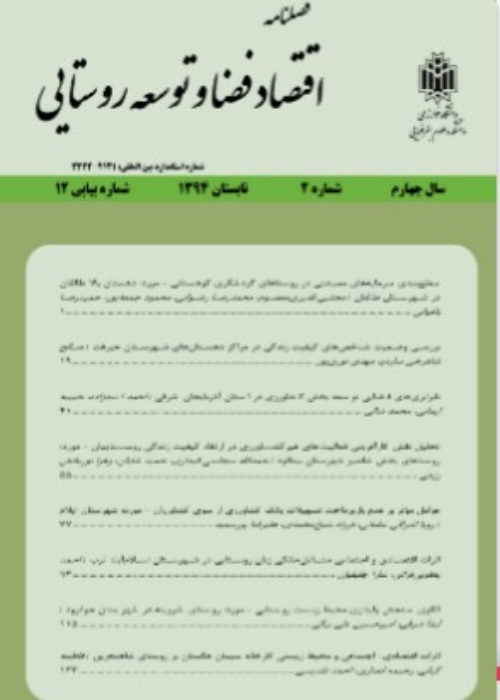Factors affecting the reorganization of the rural service management model with emphasis on economic components (Case study: Qazvin Province)
The role of villages in the economic, social and political development at the local, regional and international scale has been the main focus of rural development and rural management. Rural management in Iran went through a lot of changes after the approval of the Law on Councils and the formation of Islamic Councils in settlements with more than 20 households, and eventually, the approval of the Establishment of Self-Sufficient Rural Municipalities Act on July 5, 1998. Based on this Act, several duties are recognized for rural municipalities, including rural planning, construction service, rural health, social services, cultural services, planning for disasters, improvement of rural environmental conditions and supervision of physical development plans. These duties are similar in all villages with councils. Despite the fact that rural management services are necessary for all kinds of villages, it is not possible to provide these services; even if it is possible, the cost is not viable. In other words, we currently have expensive and costly management of rural settlements. Therefore, after two decades of new rural management, a study needs to analyze the geographical, social, cultural and economic conditions. The purpose of this study is for the new rural management to cover services as much as possible with economic efficiency, promotion of public participation and private sector, the spatial connection of settlements, applying distributed network services and reduction of functional differences, reformation in different dimensions; environmental-physical, structural-institutional, social-cultural, economic and human aspects of rural management. Thus, we can provide a suitable model for providing integrated rural management that all the rural population will be provided services according to their right.
The current research is an applied study, and the results can be used in planning and decision-making. The research method is a survey, so with social sampling techniques can be generalized to other rural areas. The data collection tool is a questionnaire, which was used for four units of analysis, including the members of the Islamic village council, the village mayors, villagers and experts. The survey is of a descriptive and explanatory type because it aims to objectively and precisely explain the process of the activities of rural municipalities and examine the relationships between variables and structures to explain and interpret the influencing factors in improving performance. This will be used for rearranging the current model of rural management with the aim of providing maximum coverage of services. The statistical population of the research includes all the cities of Qazvin province (six cities). The target counties, districts and rural districts have been selected as clusters. A total of 427 questionnaires have been completed by residents of 40 selected villages in Qazvin province. The criteria are population, distance, number and population of villages. First, nine districts were selected and accordingly, 22 rural districts and finally, 40 villages were selected.
In this paper, the factors affecting the reorganization of the rural service management model in five dimensions of environmental-physical, structural-institutional, social-cultural, economic and human aspects. The findings indicated the effectiveness of the described dimensions. Based on the findings, the followings are the most important components: in the environmental-physical dimension, components such as adopting an area instead of a point-based approach, spatial link and geographical features of the region and maximum coverage of services, in the structural-institutional dimension, the components of amending laws and regulations, creating joint construction and service organizations, increasing villager activity hours and providing services to neighboring villages, in the socio-cultural dimension, the components of fair distribution of services, accountability, performance transparency, increasing interactions and attention to vulnerable groups, in the economic dimension, the components of compliance with economic efficiency, reducing service costs, increasing productivity, sustainable sources of income, shared services, and finally, in the human dimension, components of people's participation, private and cooperative sector, reforming the selection process of village mayors and citizenship education. These components can be used for rearranging the rural management for rural service.
- حق عضویت دریافتی صرف حمایت از نشریات عضو و نگهداری، تکمیل و توسعه مگیران میشود.
- پرداخت حق اشتراک و دانلود مقالات اجازه بازنشر آن در سایر رسانههای چاپی و دیجیتال را به کاربر نمیدهد.


